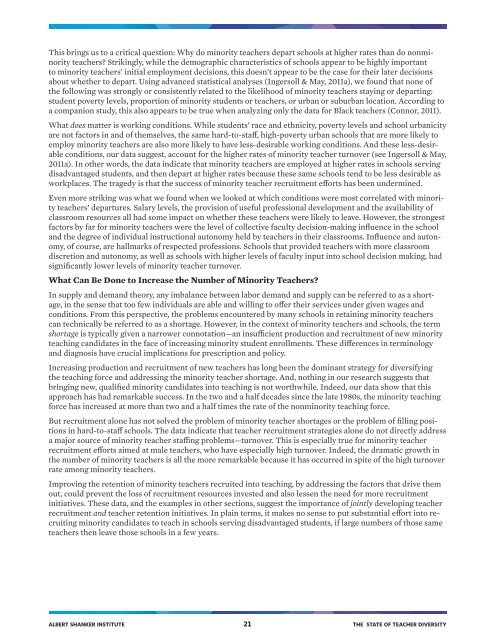TEACHER DIVERSITY
The State of Teacher Diversity_0
The State of Teacher Diversity_0
- No tags were found...
You also want an ePaper? Increase the reach of your titles
YUMPU automatically turns print PDFs into web optimized ePapers that Google loves.
This brings us to a critical question: Why do minority teachers depart schools at higher rates than do nonminority<br />
teachers? Strikingly, while the demographic characteristics of schools appear to be highly important<br />
to minority teachers’ initial employment decisions, this doesn’t appear to be the case for their later decisions<br />
about whether to depart. Using advanced statistical analyses (Ingersoll & May, 2011a), we found that none of<br />
the following was strongly or consistently related to the likelihood of minority teachers staying or departing:<br />
student poverty levels, proportion of minority students or teachers, or urban or suburban location. According to<br />
a companion study, this also appears to be true when analyzing only the data for Black teachers (Connor, 2011).<br />
What does matter is working conditions. While students’ race and ethnicity, poverty levels and school urbanicity<br />
are not factors in and of themselves, the same hard-to-staff, high-poverty urban schools that are more likely to<br />
employ minority teachers are also more likely to have less-desirable working conditions. And these less-desirable<br />
conditions, our data suggest, account for the higher rates of minority teacher turnover (see Ingersoll & May,<br />
2011a). In other words, the data indicate that minority teachers are employed at higher rates in schools serving<br />
disadvantaged students, and then depart at higher rates because these same schools tend to be less desirable as<br />
workplaces. The tragedy is that the success of minority teacher recruitment efforts has been undermined.<br />
Even more striking was what we found when we looked at which conditions were most correlated with minority<br />
teachers’ departures. Salary levels, the provision of useful professional development and the availability of<br />
classroom resources all had some impact on whether these teachers were likely to leave. However, the strongest<br />
factors by far for minority teachers were the level of collective faculty decision-making influence in the school<br />
and the degree of individual instructional autonomy held by teachers in their classrooms. Influence and autonomy,<br />
of course, are hallmarks of respected professions. Schools that provided teachers with more classroom<br />
discretion and autonomy, as well as schools with higher levels of faculty input into school decision making, had<br />
significantly lower levels of minority teacher turnover.<br />
What Can Be Done to Increase the Number of Minority Teachers?<br />
In supply and demand theory, any imbalance between labor demand and supply can be referred to as a shortage,<br />
in the sense that too few individuals are able and willing to offer their services under given wages and<br />
conditions. From this perspective, the problems encountered by many schools in retaining minority teachers<br />
can technically be referred to as a shortage. However, in the context of minority teachers and schools, the term<br />
shortage is typically given a narrower connotation—an insufficient production and recruitment of new minority<br />
teaching candidates in the face of increasing minority student enrollments. These differences in terminology<br />
and diagnosis have crucial implications for prescription and policy.<br />
Increasing production and recruitment of new teachers has long been the dominant strategy for diversifying<br />
the teaching force and addressing the minority teacher shortage. And, nothing in our research suggests that<br />
bringing new, qualified minority candidates into teaching is not worthwhile. Indeed, our data show that this<br />
approach has had remarkable success. In the two and a half decades since the late 1980s, the minority teaching<br />
force has increased at more than two and a half times the rate of the nonminority teaching force.<br />
But recruitment alone has not solved the problem of minority teacher shortages or the problem of filling positions<br />
in hard-to-staff schools. The data indicate that teacher recruitment strategies alone do not directly address<br />
a major source of minority teacher staffing problems—turnover. This is especially true for minority teacher<br />
recruitment efforts aimed at male teachers, who have especially high turnover. Indeed, the dramatic growth in<br />
the number of minority teachers is all the more remarkable because it has occurred in spite of the high turnover<br />
rate among minority teachers.<br />
Improving the retention of minority teachers recruited into teaching, by addressing the factors that drive them<br />
out, could prevent the loss of recruitment resources invested and also lessen the need for more recruitment<br />
initiatives. These data, and the examples in other sections, suggest the importance of jointly developing teacher<br />
recruitment and teacher retention initiatives. In plain terms, it makes no sense to put substantial effort into recruiting<br />
minority candidates to teach in schools serving disadvantaged students, if large numbers of those same<br />
teachers then leave those schools in a few years.<br />
ALBERT SHANKER INSTITUTE 21 THE STATE OF <strong>TEACHER</strong> <strong>DIVERSITY</strong>


